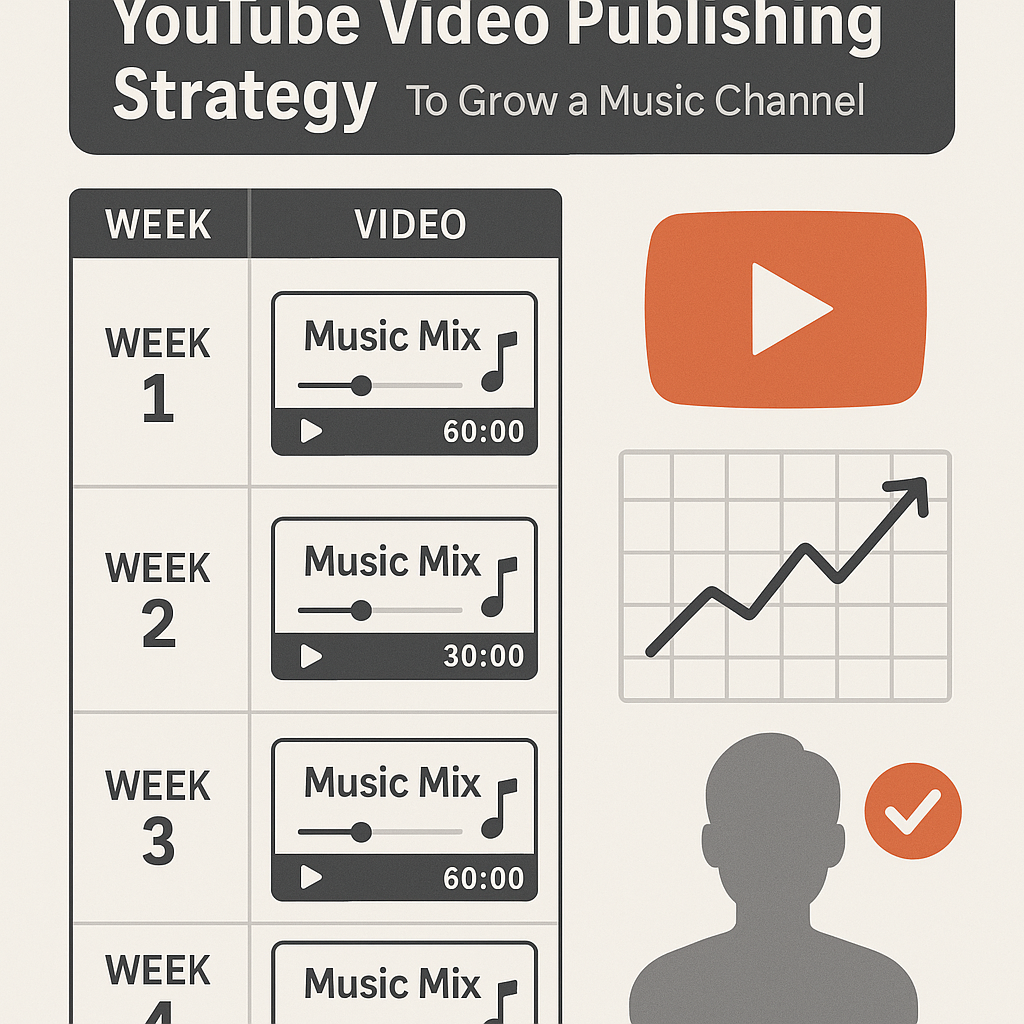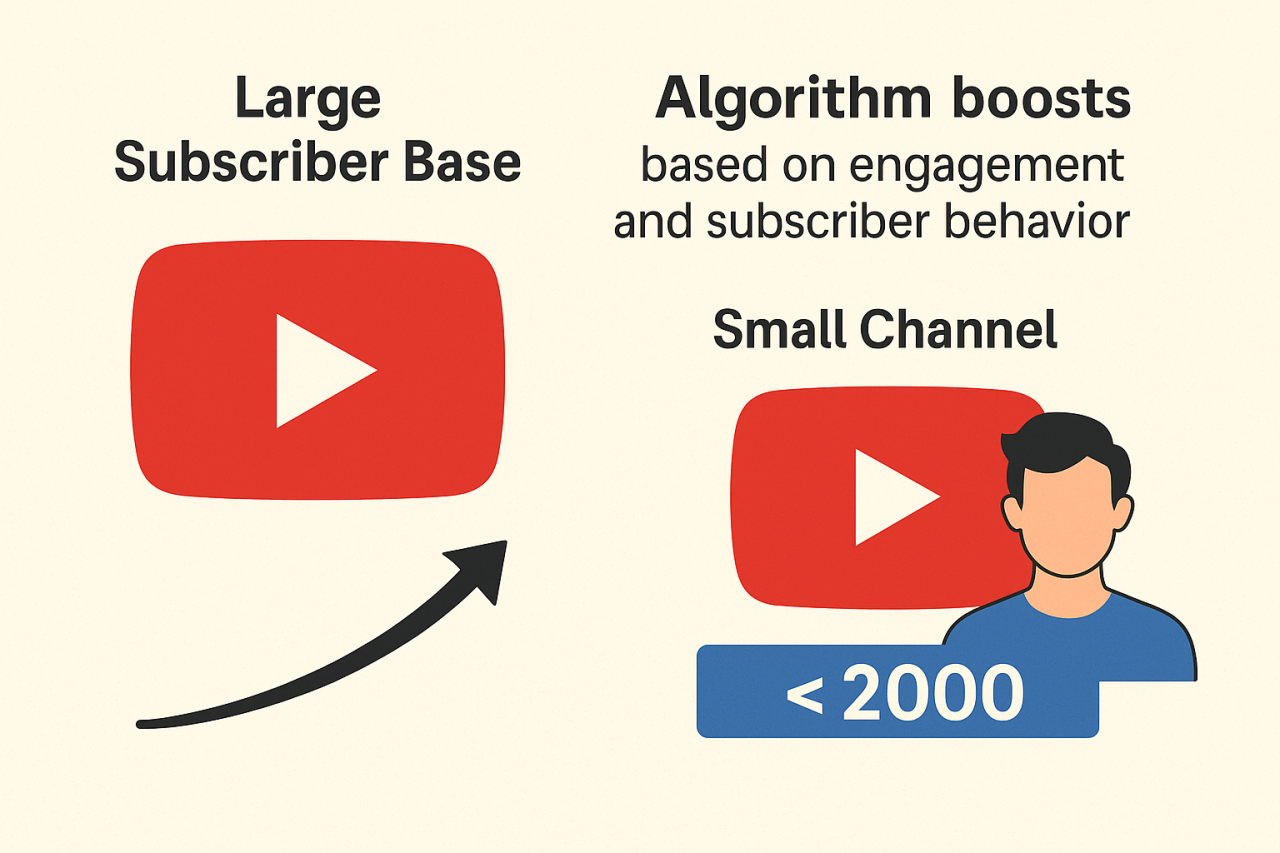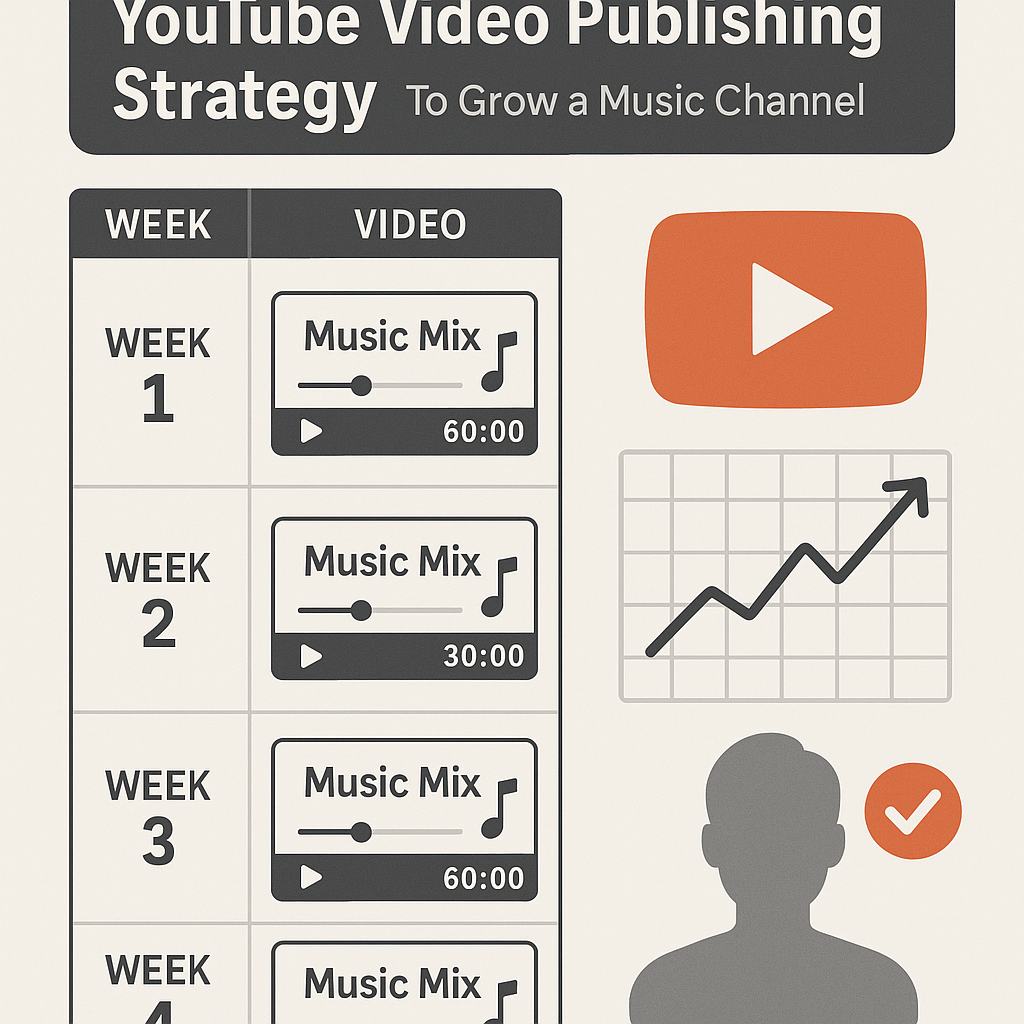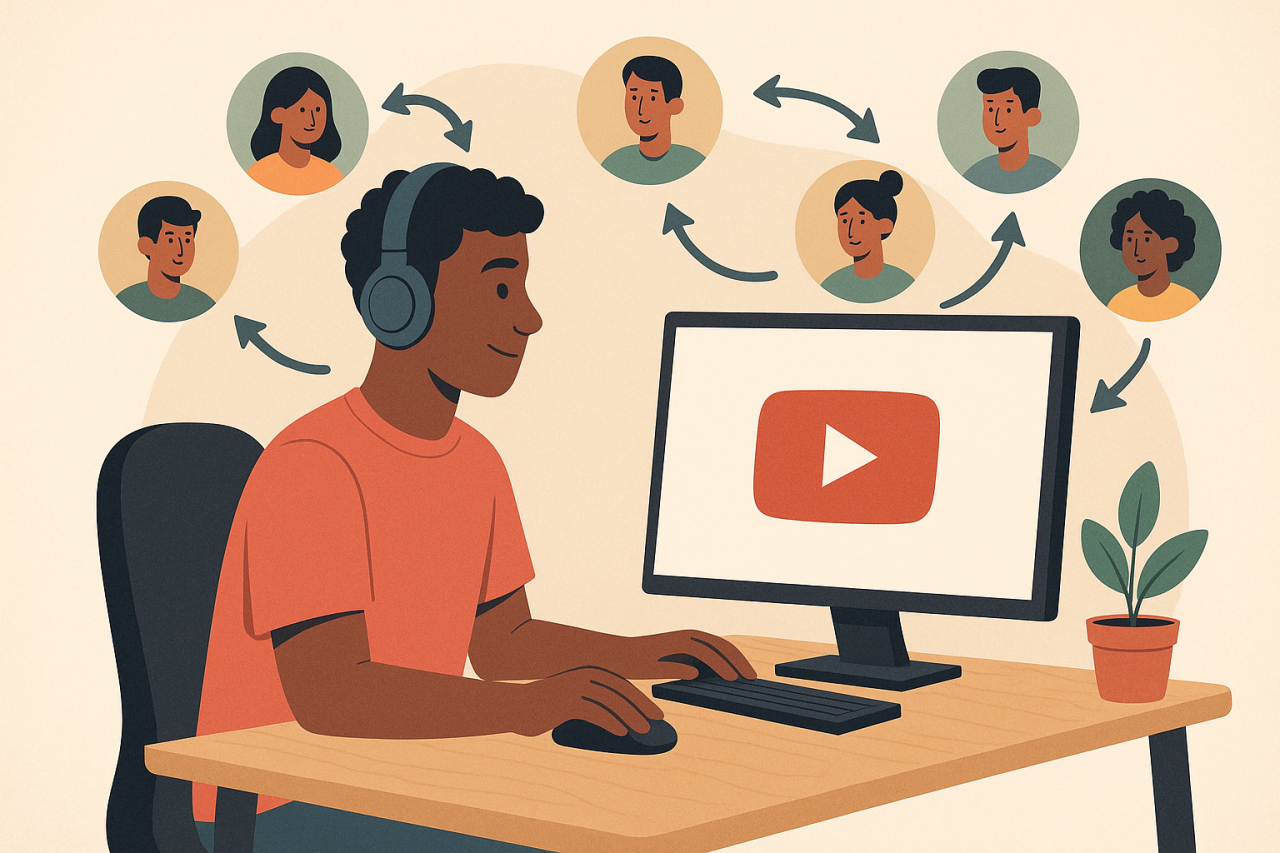YouTube’s algorithm prioritizes viewer satisfaction through metrics like watch time, click-through rate (CTR), and audience retention. Video length directly influences these metrics by shaping how viewers engage with your content. For example, shorter videos often yield higher retention percentages, while longer videos can generate more total watch time per view. This article dives into data-backed insights on long-form vs. short-form videos (including Shorts), and provides actionable tips for music content creators to optimize video length, publishing frequency, and content sequencing for sustainable channel growth.
May 03 2025 • 23 min read • 4542 words
Video Length and YouTube Algorithm: Strategies for Music Channels in 2025

- Long-Form vs. Short-Form vs. Shorts: Impact on Retention and Engagement
- Algorithmic Reach: How Different Lengths are Promoted
- Optimizing Content Mix and Publishing Frequency for Growth
- Audience Size, Engagement Declines, and Algorithmic Expectations
- Key takeaways and tactics for music creators In 2025
Long-Form vs. Short-Form vs. Shorts: Impact on Retention and Engagement
Video length has a profound effect on viewer behavior. Generally, the shorter the video, the easier it is to maintain a high percentage of viewer retention. Industry statistics show that videos under 90 seconds achieve around a 50% average viewer retention rate. In contrast, longer videos naturally see a lower percentage of completion – one analysis noted that a top-performing 30-minute video might only retain ~20–30% of viewers to the end. While 20–30% sounds low, consider that 30% of a 30-minute video is 9 minutes of watch time; that depth of engagement can strongly signal the algorithm that viewers are finding value in the content.
Short-form standard videos (say, 5–15 minutes) often hit a middle ground, with many creators aiming for 40–50% retention on a 10-minute video (equating to ~4–5 minutes average view duration). Successful music channels ensure their content justifies its length – a 3-minute song or a 15-minute in-depth tutorial should both keep viewers watching most of the way through. High retention not only pleases viewers but also pleases the algorithm: if your CTR is higher than average and your audience retention is better than your channel’s usual, YouTube will distribute that video more widely. In other words, a video that outperforms your channel’s typical retention is likely to get an extra boost in recommendations.
Engagement (likes, comments, shares) tends to be disproportionately high on shorter content. Short videos and Shorts excel at prompting quick interactions – in fact, one study found short-form videos get 2.5× more engagement than long-form videos. This is partly because viewers are more likely to watch a short clip to the end and drop a like or comment without a huge time commitment. By contrast, long videos foster deeper engagement in the form of discussion and loyalty. A viewer who sticks around for a 20+ minute music documentary or a full concert is highly invested and might be more likely to write a detailed comment or share the video with friends. Both types of engagement matter: the algorithm notices when people interact. For Shorts, YouTube’s own data shows an average engagement rate of about 5.9%, the highest among short-form platforms. So while a 30-minute video might not get as many likes per view as a 30-second Short, it can still accumulate significant watch time and meaningful feedback from your core audience.
Table: Key Metrics by Video Length
| Format & Length | Typical Audience Retention | Engagement Tendencies | Algorithmic Reach Characteristics |
|---|---|---|---|
| YouTube Shorts (Vertical, < 3 min) | High % viewed if hook is strong (often ~50% average for <90s; top Shorts can exceed 80% retention) | Quick likes/comments; ~5.9% engagement rate on average. Easy to share; can go viral rapidly. | Massive instant reach via the Shorts feed. Relies on algorithmic swipes more than search/subscribe feeds. Short lifespan – big burst of views in first 24–48h. |
| Short-Form Video (Standard YouTube, < 20 min) | Moderate-high retention (50%+ if well-paced; e.g. a 5 min music lesson often holds ~60–70% to end, 10–15 min video may see 40–50%) | Good engagement if content is concise. Viewers more likely to like & comment when video doesn’t feel “too long.” Can still spur subscribes if value is delivered quickly. | Broad reach: Appears in home feed, Suggested videos, and search results. Balanced longevity – can get initial boost and also long-tail views over weeks/months. |
| Long-Form Video (20+ min, e.g. long interviews, full albums) | Lower % retention (often 20–40% to end is common, but equates to high absolute watch time per viewer) | Fewer quick interactions per view, but deeper engagement. Loyal fans may comment thoughtfully and watch most or all, increasing total watch hours. | Strong long-term reach: Benefits from session watch time (keeping viewers on platform). Can be recommended if it maintains decent retention. Often appears in search for niche terms. Content can continue gaining views for years (“evergreen” potential). |
Why these metrics matter: YouTube’s algorithm weighs both percentage viewed and total watch time. Short content can spike percentage viewed (a viewer might watch 45 seconds of a 60-second Short = 75%), whereas a long video might deliver more minutes watched even if the percentage is lower. For example, many viewers might drop off a 30-minute upload halfway, giving 50% retention – but that’s a 15-minute average view duration, which is substantial. In YouTube’s eyes, a longer session length can indicate high viewer satisfaction, as long as viewers remain engaged. The key is to balance these factors by matching video length to content value: don’t stretch a 3-minute idea into 20, and don’t cut off valuable content for the sake of brevity. Aim to keep your audience watching as much as possible, regardless of length, to send positive signals to the algorithm.

Algorithmic Reach: How Different Lengths are Promoted
Not all video lengths are treated the same in terms of how they’re distributed on YouTube. In 2025, YouTube effectively runs multiple recommendation systems in parallel for different formats. Understanding these can help music creators tailor content for maximum exposure:
YouTube Shorts Feed (Vertical Videos < 3 min)
Shorts rely almost entirely on algorithmic discovery. Viewers usually encounter Shorts by swiping in the dedicated Shorts feed, not by searching or browsing a channel. This means if the algorithm likes your Short (high early retention, lots of likes), it can suddenly serve it to thousands of people within hours. Shorts now get a staggering 70 billion views per day globally. For music channels, a catchy 30-second riff or vocal clip can explode in reach thanks to the Shorts algorithm’s “viral lottery”. However, this reach tends to be a quick burst. Shorts often have a shorter lifespan – they might spike in views the first 1–3 days then taper off. YouTube has even adjusted the Shorts algorithm to improve recommendations for slightly longer Shorts now that creators can upload up to 3 minutes.
Important: The Shorts algorithm doesn’t use CTR the same way as long videos since Shorts autoplay in the feed. Instead, it emphasizes instant hook and retention – you have about 2 seconds to grab a scroller’s attention before they swipe away. High swipe-away rate in the first seconds will kill a Short’s reach. But if you captivate viewers, the algorithm will snowball your Short to more and more people.
Standard Long-Form Algorithm (Videos in the main feed, usually > 1 min)
Regular uploads (whether 3 minutes or 30 minutes) compete in the traditional recommendation system – appearing on users’ home pages, “Up Next” suggestions, and search results. Here, click-through rate and retention together determine success. A 10-minute music tutorial with a high CTR and above-average watch time for its length will get picked up by the recommendation engine. Unlike Shorts, these videos can steadily accumulate views over weeks or even years. They’re also indexed by search, which is huge for discoverability (e.g., someone searching “guitar cover of [Song Name]” or “how to play jazz chords” may find your 15-minute video months later). In fact, recent data shows YouTube’s user base still spends the majority of their watch time on long-form videos. As of late 2024, about 73% of YouTube watch time in the U.S. was for videos longer than 30 minutes. That’s a dramatic indication that long content remains YouTube’s “bread and butter”. The algorithm isn’t abandoning long videos; if anything, viewers are gravitating toward longer content for music and entertainment. YouTube’s own research suggests that creators benefit from using multiple formats, without Shorts cannibalizing long-form views. In other words, posting Shorts and long videos can capture different types of viewership and both thrive.
Notifications and Subscribers
Regardless of length, your subscribers are typically the first to be notified of new uploads (except Shorts, which don’t always send notifications by default). A long-form video will initially be shown to a segment of your subscriber base in their feed. If that core audience clicks and watches for a good duration, it will get recommended to more new viewers. If they ignore it or drop off quickly, the video might not get much further promotion. This is why engagement from your loyal viewers is critical, especially for long videos. Shorts, on the other hand, are more likely to reach non-subscribers right away due to the feed’s nature – subscribers might not even see all your Shorts unless they deliberately check or the Shorts also appear on Home. YouTube has recently integrated these systems more, hinting that a user’s interest in certain long-form content can influence what Shorts they see and vice versa. But by and large, think of Shorts distribution as wide but shallow (lots of impressions, quickly) and long-form distribution as narrower but deep (targeted to interested viewers, with potential to snowball through suggestions if it performs well).
Live Streams and Premieres (Bonus format)
Some music channels also use live streams (e.g. live jam sessions, Q&As, or 24/7 music streams). These aren’t the focus of this article, but it’s worth noting the algorithmic effect: live streams (or super-long videos) can generate a ton of watch time from a smaller audience and can convert into VOD after. They can notify subscribers and create appointment viewing. Some creators strategically premiere long videos (so that viewers watch together at launch) and even use an active live chat to boost engagement. According to one media tech firm, a mix of about 10% live streaming content can complement Shorts and long videos to keep watch time high on a channel. In summary, each format has a different “algorithmic lane” on YouTube. Shorts are fed to millions through a TikTok-style algorithm focusing on quick engagement; long videos are steadily recommended based on sustained interest and search relevance. Smart music creators harness both: use Shorts for reach and discovery, and long-form for depth and retention. YouTube itself has encouraged creators to diversify content length, noting that spreading across formats can expand your overall reach. The key is ensuring each video (short or long) performs well for its category – a great Short needs a killer hook and high completion rate, while a great long video needs to hold interest throughout and earn that watch time.
Optimizing Content Mix and Publishing Frequency for Growth
Balancing video lengths is not only about content, but also about when and how often to publish each type. A smart publishing strategy can keep your channel momentum high without overwhelming your audience or the algorithm. Here are evidence-based tips on scheduling and sequencing videos for sustained growth on a music channel.
Maintain a Healthy Mix
As a music creator, you likely have a variety of content ideas – full music videos, covers, tutorials, vlogs, Shorts of quick jams, etc. Rather than sticking to one format, consider a mix that plays to each format’s strengths. One suggested breakdown from industry experts is to devote roughly 60% of your content to long-form videos, 30% to Shorts, and 10% to live streams or continuous content. This “60/30/10” mix ensures you have substantial content that builds watch time (long videos), a steady stream of discoverable clips (Shorts), and perhaps occasional live interactions (streams) to strengthen community. You can adjust these percentages based on your capacity (not everyone can do live streams, for example), but the key is diversification. Don’t put all your eggs in one basket – a pure Shorts channel might grow fast and then hit a ceiling, while a pure long-form channel might grow slowly and miss out on easy wins from Shorts.
Sequencing
Alternate or Pair Content: Many creators find it effective to alternate between long and short content. For instance, if you release a 15-minute video this week, plan a couple of Shorts for the following days highlighting the best moments from that video or related musical ideas. This keeps the channel active in between big uploads and continuously feeds the algorithm with fresh material. The YouTube home feed algorithm values channels that post consistently (without large dormant gaps) because there’s always something new to test with audiences. Shorts can fill those gaps nicely, since they require less production time. Conversely, after a run of several Shorts, drop a longer video to give new subscribers something substantial to chew on. One possible sequence for a month might be:
- Week 1 – major video (e.g., a new song or in-depth tutorial),
- Weeks 2 and 3 – a Short every few days (e.g., clip of a live performance, quick tip, or trending music meme),
- Week 4 – another significant video (e.g., a cover or a Q&A).
This pattern trains your audience to expect both formats. It also leverages the fact that YouTube’s algorithm resets opportunities with each upload – a strong Short can boost your channel one week, and the next week a strong long video might ride that wave when some of those new viewers see it in their feed.
Frequency Considerations
YouTube rewards consistent output, but for music channels, quality is crucial (nobody wants a half-baked song every day). Shorts allow you to post more frequently without exhausting your creative pipeline. You might not manage more than one full production video a week or month, but you can certainly post quick updates or musical snippets in between. Some successful music YouTubers post Shorts almost daily (simple riffs, gear tests, 15-second jokes) to stay present in feeds, while reserving their bigger projects for a monthly release. If you go this route, ensure the Shorts are not low-quality throwaways – even a casual Short should provide some entertainment or value (polish the audio, make sure the guitar is tuned, etc.!). If daily Shorts are too much, aim for at least a couple per week. Remember, consistency beats volume: it’s better to upload on a sustainable schedule (e.g., one long video every other Friday and 2 Shorts each week) than to spam and burn out. Consistency conditions both your audience and the algorithm to expect regular content, which can lead to more stable growth.
By optimizing your content mix and schedule, you essentially train the algorithm on how to treat your channel. If YouTube sees that every week you produce a hit 60-second clip and a solid longer video that keeps people watching, it will feed more and more users into that cycle. Consistent performance builds trust in the algorithm’s “eyes.” The result: You’ll notice more stable view counts, higher baseline performance even for videos that don’t go viral, and fewer extreme highs and lows. This steadiness is a hallmark of sustainable growth.

Audience Size, Engagement Declines, and Algorithmic Expectations
A frequently overlooked factor in channel growth is how your existing audience size and behavior set the bar for the algorithm. In simple terms, the algorithm measures your new video against your past videos and audience. Here’s what that means and why it’s crucial for music creators.
Relative Performance Matters
YouTube doesn’t have one universal standard for “good engagement” – it’s relative to your channel’s history and viewer base. If a small music channel averaging 500 views per video suddenly makes one that gets 5,000 views, the algorithm sees that as a breakout success and will try showing it to even more people. Conversely, if a channel that usually gets 100k views on a video puts out one that only gets 10k, YouTube’s systems might throttle recommending it further, assuming it’s not resonating. This means big channels are not immune to flops, and small channels are not doomed to stay small. It’s all about engaging the people who do see the video. As a creator, you should focus on making each video appealing and satisfying to your current viewers first – that increases the chance it will then reach new viewers.
Large Subscriber Base – Boon and Baggage
Having a large number of subscribers can jump-start a video’s exposure (you have more initial viewers to notify), but it also sets a higher expectation. If you have 1 million subscribers but only 50k watch your new upload in the first day, that’s a signal to YouTube that the video might not be broadly interesting (at least to your audience). Why? Because ideally a sizable chunk of your subs, who presumably like your content, would click if it excited them. So, large channels must keep their subscriber base engaged to maintain high reach. If engagement drops – say your videos gradually go from 10% of subscribers watching to 5% to 2% – the algorithm will scale back how aggressively it surfaces your content. This sometimes happens to music channels that pivot content or go inactive for a while: the next video they drop doesn’t get as many clicks because subscribers moved on, and YouTube in turn promotes it less, causing a feedback loop of lower reach.
If you’re a smaller music channel, you actually have more flexibility to experiment without severe algorithmic penalty. With fewer subscribers, each video is already being shown to new people through search or niche recommendations. YouTube’s “adjustments designed to help small creators” mean that if your content is good, it will try to find an audience for it even if you don’t have a big base. Focus on high retention and satisfaction for whoever does watch, and you’ll notice each subsequent video doing a bit better. The expectations are lower, so it’s easier to exceed them and trigger more reach.
Usually reaching 2000 subscribers changes your channel boosting.
Sustainable growth is about maintaining positive momentum. When your engagement is consistently strong (relative to your size), YouTube’s algorithm might even give you some leeway on a less successful video – it might test it with more audiences just because your channel is “known” to do well. On the flip side, if you have a streak of underperforming videos, it can take a few hits to regain that momentum. This is why many seasoned YouTubers say never to coast on past success. Each upload is a fresh chance to delight (or disappoint) viewers. Keeping an eye on your channel’s health (metrics like average view duration, average % viewed, engagement rate per video, etc.) over time can alert you to downward trends before they become algorithm problems. If you catch a dip early (say your past 5 videos have gradually declining retention), you can take action in your next video to punch that metric up again.
Inactive or “Dead” Subscribers
Music channels often experience spikes of subs from one-off viral hits (e.g., a viral cover song, or a trending Short as discussed). Not all those subs stick around to watch future videos. They’re colloquially called “dead subs” when they no longer engage. A moderate percentage of inactive subs is normal for any channel, but if you have a disproportionate number, it can drag down your averages. For instance, if 100k people subscribed because of a funny Shorts series you did, but you’ve since shifted to only uploading 30-minute music theory lessons, those 100k might ignore your uploads. The first 24–48 hours of a video’s life are crucial; if a large portion of the people who see it (often including your subs) don’t click or don’t watch for long, the video’s further reach will be limited. Solution: It circles back to balancing content. It’s okay if not every subscriber watches every video (that’s impossible), but try to continuously engage the various segments of your audience. If you have a Shorts-loving crowd and a long-form-loving crowd, alternate content so neither group goes too long without something for them. Also, occasionally reintroduce yourself and your content in a way that might re-engage those lapsed subs. For example, “New here from my Shorts? Here’s why my full videos are worth a watch…” – a bit of messaging can go a long way.
What to Do When Engagement Declines
Almost every channel faces periods of plateau or decline. Maybe your recent songs didn’t resonate as much, or you took a break and views dipped. When YouTube notices a downturn in engagement (lower retention, fewer likes, etc.), it may reduce your impressions (your videos show up less in feeds). To bounce back:
Premium content
Log in to continue

Key takeaways and tactics for music creators In 2025
For YouTube music channels in 2025, video length is a strategic lever for growth. Long-form videos (20 minutes and beyond) build watch time, deeper connection, and loyalty – they’re where casual viewers become true fans as they invest more time in your art or personality. Short-form videos (under 20 minutes) and YouTube Shorts (now up to 3 minutes) are your discovery engines – they capture attention quickly, perform well in the algorithm for impressions and engagement, and bring new eyeballs to your channel. The creators thriving on the platform are those who balance both: leveraging Shorts for reach without letting it become “empty calories,” and leveraging long content for substance without ignoring the modern short-form wave.
Use data to inform your video lengths Check your retention graphs and audience feedback. If viewers drop off after the second chorus, maybe your music video doesn’t need that 3rd chorus reprise. If your 2-minute Shorts consistently get full watches, you might experiment with 120-second Shorts now that the limit is higher, to tell a richer story (the platform is improving longer Short recommendations). Always ask: “Is this video as long as it needs to be and no longer?” – provide value or entertainment at a good pace, and viewers will stay.
Repurpose and cross-promote content Every long video can potentially spawn several Shorts (highlights, behind-the-scenes clips, etc.), and every Short can be a trailer for a longer video. This not only saves production effort (get more mileage from the same content), but also creates multiple touchpoints for viewers to find you. A viral Short might be someone’s first introduction to your music; a suggested long video could be the second, and together they paint a fuller picture of your channel.
Keep a consistent rhythm Develop a publishing schedule that fits your life and stick to it. Whether it’s “new cover every Friday and Shorts in between” or “monthly music video, with weekly quick jams,” consistency builds anticipation. Over time, your audience will know what to expect (“Oh, it’s Tuesday, there should be a new piano cover up”) and the algorithm will recognize your regular activity, feeding users accordingly.
Engage your community Encourage comments, ask questions, run polls, and respond when you can. Engagement boosts are especially helpful for the algorithm. For example, ending a long video with a question like “Which song should I cover next? Let me know in the comments!” can prompt a flurry of interaction, signaling YouTube that viewers weren’t just watching passively – they cared enough to respond. Similarly, a Short that says “Duet this!” or “Comment your favorite lyric” can drive engagement beyond just views. An active community also means when you do try something new (a different length or format), they’re more likely to support it, cushioning any algorithmic risk.
Monitor trends but prioritize your niche The YouTube ecosystem in 2025 is competitive, and music trends can be volatile (today a sea shanty is trending, tomorrow it’s lo-fi beats). While it’s smart to ride relevant trends (e.g., a 15-second clip on a meme song in Shorts to attract viewers), make sure your long-form content delivers on what those viewers are looking for beyond the trend. That’s how you turn trend-chasers into long-term subscribers. Use Shorts to hook into cultural moments, and long videos to showcase your unique musical identity and expertise.
To maintain a consistent weekly upload schedule for your music-focused YouTube channel in 2025, it's essential to balance long-form content with shorter videos. This strategy aims to optimize both average view duration (AVD) and total watch time, aligning with YouTube's algorithm preferences.
Here is how to apply this strategy and grow your music channel in 2025.
Premium content
Log in to continue
You might like

YouTube Creators: How Many Returning Viewers Do You Have?
May 19 2025
YouTube’s Algorithm In 2025: A Creator’s Guide to Discovery and Growth
May 04 2025
How YouTube Playlists Boost Music Channel Performance
May 04 2025
YouTube Video Content vs. AI Realism: Why Creator Survival Won’t Be Easy
May 30 2025